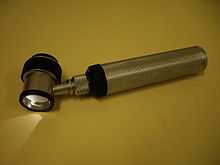Nevus (or naevus, plural nevi or naevi, from nævus, Latin for "birthmark") is the medical term for sharply circumscribed[1] and chronic lesions of the skin. These lesions are commonly named birthmarks or beauty marks. Nevi are benign by definition. However, 50% of malignant melanomas (a skin cancer) arise from pre-existing nevi.[2] Using the term nevus and nevi loosely, most physicians and dermatologists are actually referring to a variant of nevus called the "melanocytic nevus", which are composed of melanocytes. Histologically, melanocytic nevi are differentiated from lentigines (also a type of benign pigmented macule) by the presence of nests of melanocytes, which lentigines (plural form of lentigo) lack.
Classification
Epidermal nevi are derived from keratinocytes or derivatives of keratinocytes. Connective tissue nevi are derived from connective tissue cells like adipocytes and fibroblasts. Vascular nevi are derived from structures of the blood vessels. See birthmark for a more complete discussion
Melanocytic nevus
- Congenital nevus: a melanocytic nevus present at birth or near birth.
- Acquired melanocytic nevus: a melanocytic nevus acquired later in life, and not at or near birth. Most melanocytic nevi are of the acquired variety.
- Melanocytic nevus (nevomelanocytic nevus, nevocellular nevus): benign proliferation of melanocytes, the skin cells that make the brown pigment melanin. Hence, most nevi are brown to black. They are very common; almost all adults have at least one, usually more. They may be congenital or acquired (usually at puberty).
- Dysplastic nevus: usually an acquired melanocytic nevus with abnormal features making it difficult to distinguish from a melanoma. It can be a marker for an individual at risk for developing melanomas.
Epidermal nevus
- Epidermal nevus: congenital, flesh-colored, raised or warty, often linear lesion, usually on the upper half of the body.
- Nevus sebaceus: variant of epidermal nevus on the scalp presenting as a hairless, fleshy or yellowish area.
Connective tissue nevus
- Connective tissue nevus: fleshy, deep nodules. Rare.
Vascular nevus
Diagnosis of nevi

A dermatoscope

A modern polarized dermatoscope
Clinical diagnosis of a melanocytic nevus from other nevi can be made with the naked eye using the ABCD guideline, or using dermatoscopy. The main concern is distinguishing between a benign nevus, a dysplastic nevus, and a melanoma. Other skin tumors can resemble a melanocytic nevus clinically, such as a seborrheic keratosis, pigmented basal cell cancer, hemangiomas, and sebaceous hyperplasia. A skin biopsy is required when clinical diagnosis is inadequate or when malignancy is suspected.
Normal evolution or maturation of melanocytic nevi
All melanocytic nevi will change with time - both congenital and acquired nevi. The "normal" maturation is evident as elevation of the lesion from a flat macule to a raised papule. The color change occurs as the melanocytes clump and migrate from the surface of the skin (epidermis) down deep into the dermis. The color will change from even brown, to speckled brown, and then losing the color and becomes flesh colored or pink. During the evolution, uneven migration can make the nevi look like melanomas, and dermatoscopy can help in differentiation between the benign and malignant lesions.[3]
See also
References
External links
Diseases of the skin and appendages by morphology |
|---|
| | Growths |
|
|---|
| | Rashes |
With
epidermal
involvement |
Eczematous | |
|---|
| Scaling | |
|---|
| | |
|---|
| | |
|---|
| Pustular | |
|---|
| Hypopigmented | |
|---|
|
|---|
| Without
epidermal
involvement |
Red |
|
Generalized | |
|---|
| Localized | |
|---|
| Specialized | |
|---|
|
|---|
| Nonblanchable
Purpura |
|
|---|
|
|---|
| Indurated | |
|---|
|
|---|
|
|---|
| Miscellaneous
disorders |
|
|---|
|


